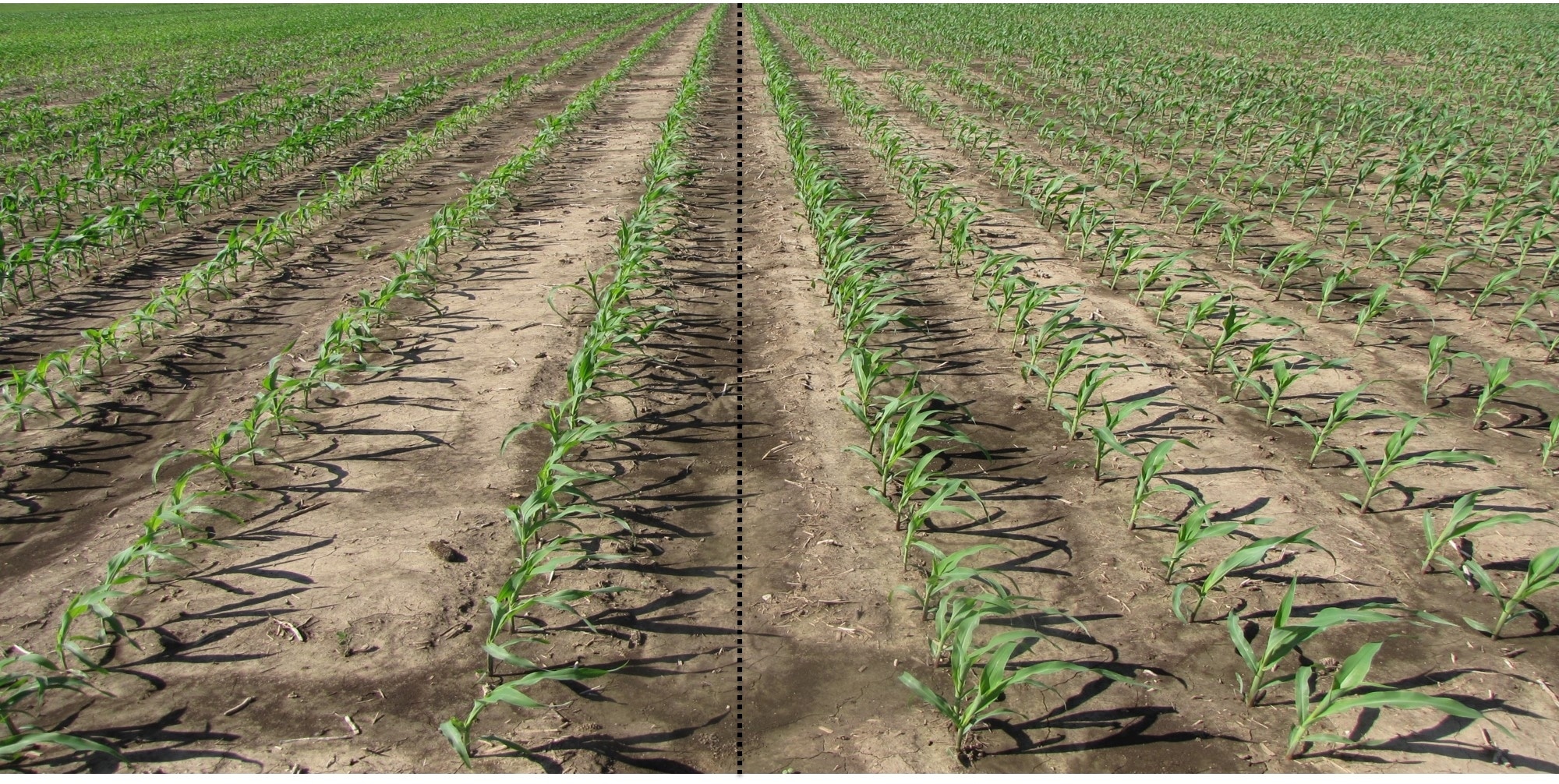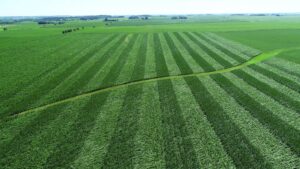The latest research and reflections from academics and seed companies on narrower row spacing, planting density and more.
Whether to plant corn, soybeans and other row crops in narrower rows: “It’s a question we definitely keep getting,” says Jason Gahimer, practical farm research operations manager at Indiana-based Beck’s Hybrids.
During the past few years, Beck’s has compared 15-, 20- and 30-inch rows in corn across multiple U.S. states, but has no definitive conclusions at this point.
“Our results vary year to year, and in the same year, from location to location,” Gahimer says. “We actually believe when farmers have different soil types and farm locations, all three factors, population, row spacing and hybrids, should be changed, but the biggest benefit may be in narrower spacing.”
To better investigate, Beck’s created a planter in 2018 enabling them to change row width, hybrids and seeding rate. Using this machine in Central Indiana, the firm found that 10-inch rows provided the best yields in silt loam soil with more organic matter. However, in more heavy clay soil with less organic matter, 30-inch performed best. In all cases, the optimal planting rate was under 40,000 plants per acre, but Gahimer says more research on all factors is needed.
Taking a less approached view is Fred Below of the University of Illinois, who firmly believes corn’s future lies in narrower rows. This professor of plant physiology and his team of graduate students have trialed corn in 20-inch rows for six years all over the state, finding a yield advantage over 30-inch rows.
“It adds up to a yield boost of 10 to 15 bushels per acre in our research, and the seed firms I’ve talked to agree with this,” he notes. “I suspect that 15-inch would be similar, and you’d be able to manage even higher densities. Let’s say a farmer plants 38,000 plants per acre in 30-inch rows, with each plant 5.5 inches apart, which is the minimum needed. In a 20-inch row, you get 5.5-inch spacing at a planting rate of 56,000.”
Below says the average corn planting density across the United States is about 32,000 plants per acre right now, and that this increases by about 400 plants every year.
While Below believes narrower rows are a way to achieve substantially higher corn planting rates, he cautions: “It’s not a trivial investment. You need a different planter and combine head too. And secondly, which is a related serious barrier, the resale value of a 20-inch planter is much less than a 30-inch, so farmers would lose money when it came to trade-in value.”
Because of this, Below expects it’ll be about 10 years before the percentage of corn farmers using 20-inch rows increases.
“I think it will be exponential at that point,” he says. “If grain prices were higher, you’d see it move quicker. I think it’ll take some farmer-leaders to do it, to show farmers that it’s working for another farmer over thousands of acres. Farmers generally feel research by seed companies is to some extent biased, that research by academics is somewhat convincing, but what other farmers are getting has by far the most influence.”
Below’s team has found another advantage of growing corn in narrower rows in research that’s about to be published.
“As you increase density, each individual plant has a smaller root system, so it’s more exposed to water, nutrient and standability issues,” he explains. “Plants in 20-inch rows have root systems that are larger by 20 to 25% than those in 30-inch rows, at every density from 38,000 to 56,000.”
However, Below believes the greatest advantage of narrow rows is seen when farmers employ a systems approach that combines more and better-placed fertilizers, higher planting populations and fungicide spraying because of less airflow.
“Six years ago,” he says, “we almost never saw 300 bushels per acre in our research trials, and now it’s routine with placing fertilizer in the row at planting with proper crop management.”
Narrow Rows with Irrigation
In Kentucky, Chad Lee and his team have found 15-inch rows provide a yield advantage compared to 30-inch rows with high plant populations, but that’s with irrigation in place. The director at the Grain and Forage Center of Excellence at the University of Kentucky and his team have studied irrigation with 15-inch rows and in-furrow fertilizing. That resulted in yields of 300 to 325 bushels per acre, both with and without the in-furrow treatments, but he says more research is needed.
To get a sense of the bigger picture, Lee did a review of published narrow-row corn studies. He says that in looking at these trials, there seems to be a yield advantage of 3 to 5% north of the Iowa-Minnesota state line, but to the south of that, it’s “hit or miss.” Drought, he notes, can be a significant factor in more southern latitudes, and that it isn’t much of an issue where Below does research in Illinois. Lee adds that although corn roots may be larger with narrower row spacing, in a drought situation the plants may fight for water against each other, and he would not recommend narrower rows as a drought-resistance strategy.
“In the latitude and soil types of Kentucky, the only reason to go to narrow rows is to push plant population,” he explains. “We know from our research that narrower rows do not provide any light interception advantage for the crop at the same planting population versus wider rows, but with increased planting populations in narrow rows, we did see more light interception and faster canopy closure.
“I’ll go one step further and say that in our soils, at our latitudes, the only way to get a yield increase in 15-inch rows (a 5 to 10% increase) is with 50,000 or 55,000 plants per acre. In this region, that requires irrigation. So wherever growers are, they have to look at their latitude, their soils, their typical planting and growing conditions, look at the research done there and make their decisions on row spacing in corn accordingly.”
Similarly in its row-spacing work, Bayer Crop Science has generally seen that many factors influence yield response. Echoing the thoughts of Below and Lee, Bayer U.S. Product Communications Lead Brian Leake notes that “one of the considerations in going to narrower rows is for in-season access for nutrient management as well as the upfront capital investment needed to shift an operation from 30-inch to narrow rows.”
Farmers will need to do the math, he says, “to determine if the yield and agronomic benefits pencil out for their operation.”
Leake believes that over the long term in corn, narrower rows do provide the opportunity to consistently increase density as well as gain benefits from earlier canopy closure, resulting in better weed suppression and improved moisture preservation. However, like Below, Leake notes that even with advancements in new technologies and plant breeding that will support the shift to narrower rows, it “may not be a mainstream practice within the next 10 years.”
The question that Below is most often asked by seed companies is whether response to planting density in corn is the same as it is to narrow rows.
“If that’s the case,” he explains, “they can make their hybrid breeding program selections accordingly, and not have to try and evaluate hybrids across different row spacings, which is a huge amount of effort.”
Below’s answer to this persistent question? While he and his team have found a relationship exists, plants that like higher densities do ok in narrow rows, he says that in the end, “the relationship isn’t as strong as companies would like.”













